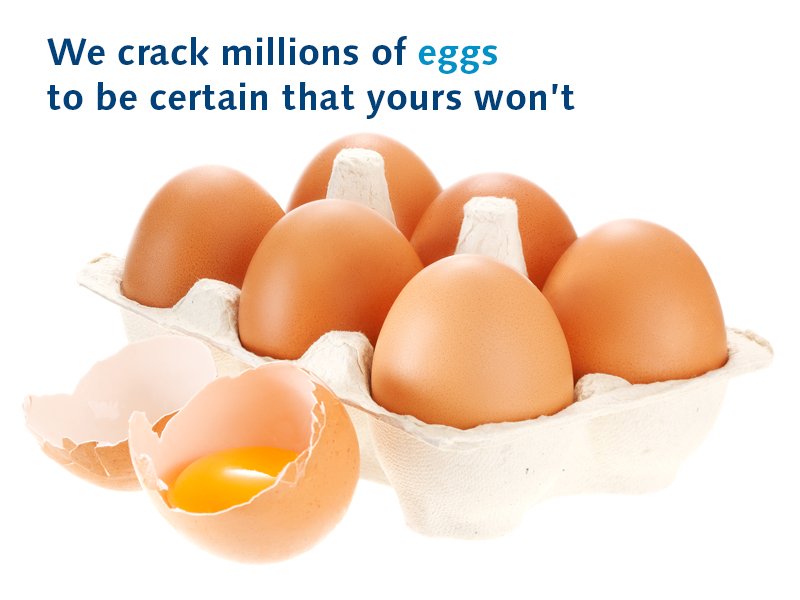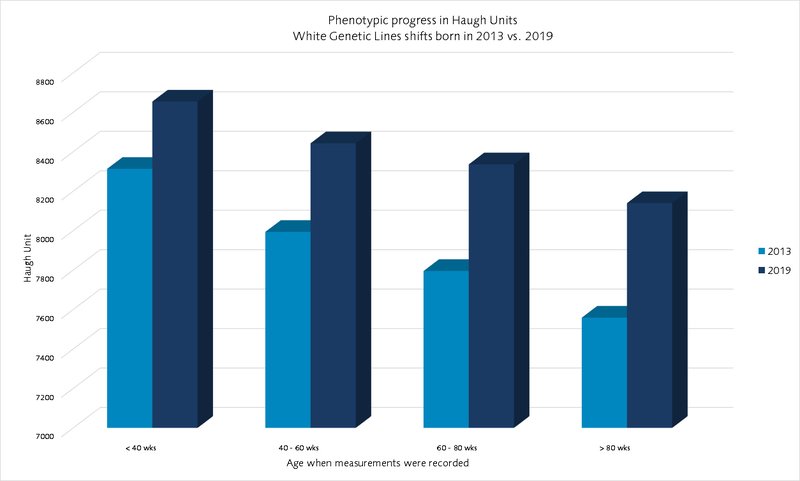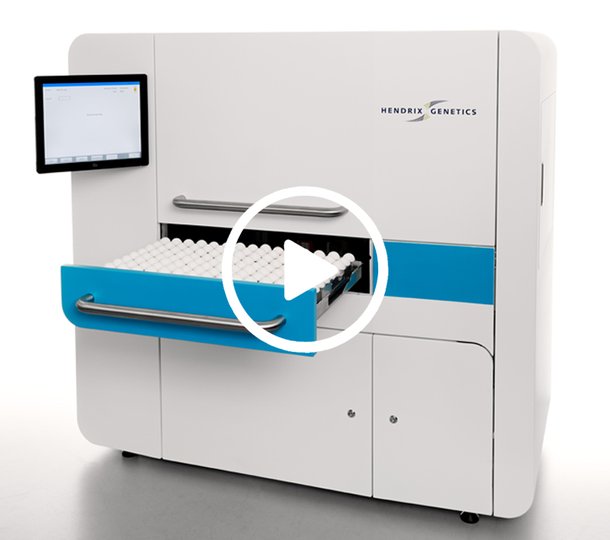
Published on Nov. 1, 2020
We crack millions of eggs to make sure yours won’t!
Breeding laying hens is not just about selecting the best birds for improved persistency, higher productivity or better livability. Breeding the perfect egg is essential when it comes to breeding laying hens. In the end, it is the egg which is the final product that ends up in the grocery store and on our plates. It is the quality of the egg that influences the consumer’s willingness to buy eggs, and rebuy them next time (it is one of the only products where people actually open the box already inside the grocery store to check how the eggs look like). As the egg is so important in my day-to-day work, it was my (nowadays retired) colleague Dr. George Ansah, who once referred to geneticists as actually being egg designers. Which is true, via breeding and selecting you can influence eggs a lot, and this is also what has happened during the past 100 years of egg selection.
External Quality
During this century of egg selection, the 1 thing that changed a little is the shape of the egg. The so-called egg-shape, with the round bottom, and the pointy tip. Differences do occur, and the strangest shapes might sometimes pop-up when sorting your eggs. When the incidence of these misshapen eggs is going up quickly, it is time to ring the alarm bells, as it most likely a disease causing these unwanted (but sometimes fascinating) phenotypes. Laying hens affected by Infectious Bronchitis (IB) have the tendency to produce large percentages of these misshapen eggs.
Breeding for rounder (like Ping-Pong balls), or pointier eggs is possible, but unwanted by the egg-industry and retail. Misshapen eggs are harder to incubate as it is harder to locate the air chambers (when too round), or they have a higher chance to break during egg handling and egg transport as they don’t role greatly over the egg belts and they do not fit nicely in the egg cartons. As a result of selection, clear differences can be seen in egg quality between eggs produced by laying hens versus eggs coming from broiler breeders. As egg quality got less attention during selection in broiler breeders compared to laying hens.
Shell breaking strength got greatly improved over the years, currently the largest focus in the breeding program on these traits is placed around persistency in breaking strength towards the end of the laying cycle. For most breeds there is no clear need to improve the level of breaking strength till peak production. Breaking Strength is clearly this trait with an optimum, you can imagine that eggs with too high breaking strengths make life difficult for unborn chicks that want to hatch out of the eggs.

Adopting the latest technologies in phenotyping
Time is not standing still within the breeding programs of Hendrix Genetics. We have adopted Robotics, Vision and image analyses in our breeding program in order to bring the phenotyping of eggs to the next level. Our Eggxaminator allows to automatically score and grade the eggs objectively. By eliminating the human interference, we have been able to bring the accuracy of our measurements to the next level! The Eggxaminator is the result of an intensive collaboration between Hendrix Genetics and our Technology partners in the Brainport region
One of the most visible traits is eggshell color, the breeding goal is that white eggs need to become whiter (although they have all reached the minimum white standard of 85 LAB), while the brown eggs need to become more intense brown. Breeding for lighter eggs is easier compared to breeding for darker eggs, as eggs become lighter as birds mature. I.e. white eggs will automatically become whiter as the laying hens get older. Unfortunately, brown eggs become less brown with aging of the birds, the goal is here to decrease the decline in eggshell color via genetic selection as much as possible. As a breeding company we do observe a growing trend in the offering of different eggshell color varieties, Blue, Olive, Chocolate brown and tinted are among our current portfolio.

Internal Egg Quality
As with many things in life, it is not just about the outside, it is also the inside of the egg that counts in the world of poultry breeding! Via genetic selection we have been able to reduce the amount of blood and meat spots in our breeds. The occurrence of blood and meat spots are often misinterpreted for being chick embryos and they negatively influence the joy of eating an egg. Despite the amazing developments in the world of egg sorting and grading machinery, there is the ever-reduced chance that you accidently come across an egg containing a blood or meat spot (mostly meat spots, as they are harder to identify with the current egg grading technologies compared to blood spots). Despite the low heritabilities we are also contributing to the reduction of blood and meat spots via our breeding program via preventing the birds that show these defects from being selected.
Haugh units is this other interesting trait when we talk about internal egg quality. The Haugh unit (pronounced as “how unit”) is a measure of the internal quality of an egg. The Haugh unit has been named after Raymond Haugh, who introduced this measurement in 1937. Especially in the South East Asian countries the Haugh unit is one of the most important indicators of egg quality, this is partly related to the high use of raw eggs in their local cuisine. Haugh Units is used as an important indicator for the freshness of the egg. It should be noted that the Haugh unit does not reflect the nutritional value of an egg. Genetic line differences occur in average Haugh Unit values, some of the black varieties are known for their exceptionally high Haugh Units.

How to measure Haugh units?
At first an egg is weighed and then broken onto a flat surface. The height of the thick albumen (the egg white) is determined with a micrometer. The thick albumen height, correlated with the weight, determines the Haugh unit rating. The significance of measuring Haugh units is that there is corrected for the size of the egg, in this way the relative albumen height is calculated and is it fairer to compare eggs of different weights. In general, the higher the number, the better the quality of the egg. The fresher the egg, the higher the thickness of the egg white. The older the egg becomes, the lower the Haugh unit will be, Haugh unit is negatively affected by high storage temperatures.
The Haugh unit formula explained:
HU = 100 * log10 (h – 1.7w0.37 + 7.6)
HU = Haugh unit
h = observed height of the albumen in millimeters
w = weight of egg in grams
The taste
The taste of an egg is heavily influenced by the diet fed to the hens, or by the circumstances during egg storage (it is strongly advised to keep your eggs in the refrigerator, but do keep them away from chopped onions, garlic, fish or any stinky cheese variety). Via our breeding program we are not selecting for a specific taste of the egg. For many years we have applied marker assisted selection (patented by Hendrix Genetics) to test if our brown egg layers were predisposed for the fishy taint in eggs. Fishy taint in chicken eggs was first described in 1948, it was found among a batch of eggs produced by Rhode Island Reds. Many studies since have shown that there is an interaction with the diet of the birds, in particular, chickens fed with diets containing high concentrations of rapeseed or fish meal. An interesting finding is that this mutation has only be found in the breeds producing brown eggs.
In conclusion
Breeding for egg quality is at the heart of our balanced breeding programs. Both the outside, as the inside characteristics are among the key traits in our selection indexes. By investing in the latest technologies, applying balanced breeding and cracking millions of eggs on a yearly basis we make sure that yours won’t, unless you crack it yourselves!


